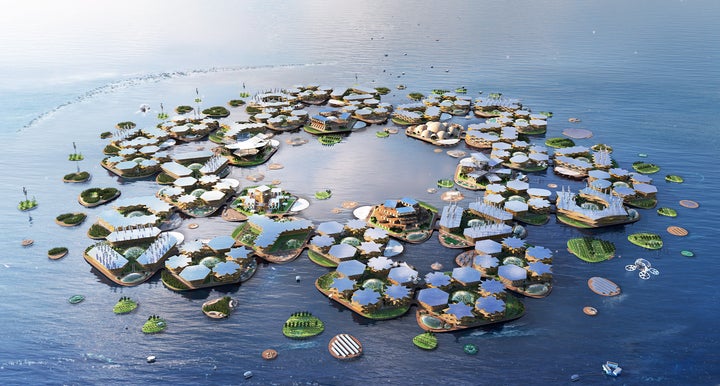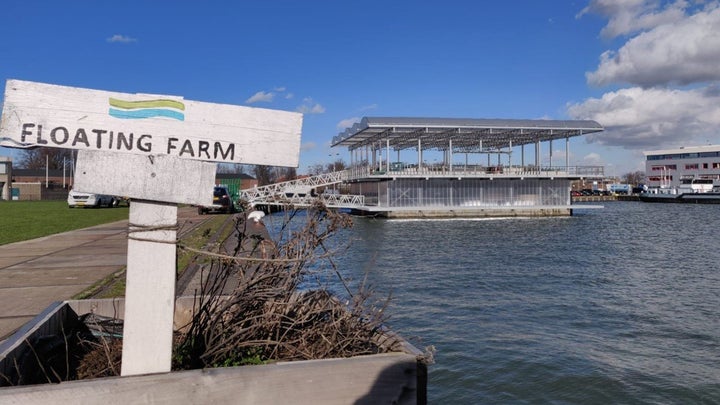
The world’s first floating farm will soon welcome aboard 40 cows. Built in Rotterdam harbor in the Netherlands, the “cow garden” and high-tech dairy farm are nearing completion.
“The building is as good as ready, we are now installing and testing the machines, and in four weeks the cows will arrive,” says Peter Beladon, the developer behind the farm. The floating farm plans to recycle cow waste, grow grass, produce milk and yogurt onsite, harvest rainwater and use its own solar energy.
This floating prototype may not be as fantastical as it sounds, even in a country where pastureland stretches for miles around. As sea levels rise, and there is ever less land for a growing urban population, this farm could be a precursor to entire floating cities in the future.

Last week, UN-Habitat, tasked with improving the world’s urban future, brought together 70 people – from engineers and architects to Hollywood executives – to discuss the feasibility of making science fiction reality: Building an entirely self-sustaining, floating city.
For advocates, these water-based communities are an exciting, innovative solution to climate change, sea-level rise and an increasingly urban population seeking affordable housing. To others, floating cities are a costly and untested distraction from the very real work we need to do in existing cities to mitigate against climate change devastation.
By 2050, nearly 70 percent of the world population is predicted to live in cities, up from just over half today. Not only will this urbanization put huge pressure on cities’ housing, transport, energy and infrastructure, but also this move is happening in the context of rising sea levels and an increase in extreme weather events that threaten cities across the world.
“People move into cities drawn by jobs, education and opportunities but too often end up living in slums,” said Maimunah Mohd Sharif, UN-Habitat’s executive director. “Climate change and rising sea levels are very real, and we have to look for innovations that are resilient. I think that the floating cities could be one of the innovative solutions… to provide housing for the vulnerable or climate refugees.”
The UN-Habitat event saw a new development company, Oceanix, launch its vision for a floating city: six hexagonal platforms around a central harbor, sustaining 10,000 people. Glossy images feature people on paddle boats, farming a plant-based diet or meditating in a bamboo spiritual center.
With a design inspired by lily-pads and the efficiently-structured cells of a honeycomb, the 75-hectare city would be anchored to the seabed by biorock, currently used to grow artificial reefs, with infrastructure to collect rainwater and de-salinate sea water. Residents would be able to grow and catch their own food and recycle their waste; the city would be powered by renewables, Oceanix claims, adding it would be designed to withstand storms.

To come up with the proto, the private, for-profit company is partnering with the Massachusetts Institute of Technology and with Bjarke Ingels of the Danish architectural firm BIG – which has previously created floating shipping container housing for students.
“We are proposing a model for sustainable urbanism, a model we believe we can do on the water where we won’t have issues with flooding,” said founder and chief executive of Oceanix Marc Collins Chen. He first started investigating cost-effective solutions for rising sea levels as a government executive 12 years ago in Tahiti.
Nobody has yet constructed a floating city yet, although the organizations Oceanix is working with have made a number of ocean infrastructures all over the world. “There is no lack of expertise – nobody has put all the pieces together and that’s what we are hoping Oceanix will do,” said Collins Chen.
The company says it has offers from investors and host cities for a small-scale prototype and expects to make an announcement “in a few weeks.”
Collins Chen said they are aiming to build affordable housing first. “Once you’ve developed a pipeline, there’s nothing to say you can’t go up the scale, but if you build for the wealthiest, it’s difficult to drive prices down,” he says.
No costing figures have been released, but Collins Chen claims the city is achievable by making savings on three areas: using “practically free” water rather than expensive land, constructing modular units in factories rather than on-site and regulating the developer’s profits.
Some experts believe we should at least give a floating city a go. Nick Makris, director of the center for ocean engineering at MIT, which is a partner in the project, thinks the first Oceanix design could work, but only if it is based in a sheltered, harbor-like environment where it’s less exposed to extreme weather.
“When you look at what was proposed, a lot of people said it’s fantastic and science fiction-y,” he says. “But from the perspective of a marine engineer, I would say that what was presented is doable in certain environments.”
But others in the field of climate change are far more skeptical – especially at the rush to throw resources into high-tech, untested ideas which don’t address the underlying causes of climate change.
“We need to work intensely on reducing greenhouse gas emissions, to reduce the damage that will happen, and on preparing our cities for damage that will occur regardless of our best efforts,” said Michael Gerrard, director of the Sabin Center for Climate Change Law at Columbia Law School.
“Floating cities might be able to accommodate tens or hundreds of thousands of people, but not the hundreds of millions or billions of people who may be displaced by climate change later in the century,” he added.
Floating cities could also present environmental challenges, said Professor Martin Siegert, co-director of the Grantham Institute of Climate Change and the Environment. “There is the issue of water quality and circulation,” he said. “We see every year in Venice algal blooms that represent problems in health and air quality, as well as water quality. Perhaps we can do more than we currently do, but I’d be surprised if this was a solution to what is a very big problem; habitability of coastal regions under storm surges.”
A further challenge is the base of the floating structure. It’s made from concrete, which carries pretty heavy environmental impacts. “The concrete platform is cost-efficient [and] one of the options we have talked about during these early phases of concept, but as we move forward we may explore other options,” said Alana Goldweit, project leader at BIG and designer for Oceanix City.
She added that the six-sided shape and sea-floor anchorage will provide stability in a storm, but there are other options for truly bad weather. “We understand when there’s a severe storm people won’t be around their terraces on the fourth floor of the building,” she says. “We have designed a refuge room in every two-hectare neighborhood that can accommodate well over 300 residents.”
The design team at BIG say that the first prototype city could be built within the next two years – but, to the disappointment of the floating farm developers in the Netherlands, its plant-based community will not be making space for cows.